Mexican grass-carrying wasp
(Isodontia mexicana)
Conservation • Description • Habitat • Ecology • Distribution • Taxonomy
|
|
||||||||||||||
Description |
Mexican grass-carrying wasp is a slender, solitary, thread-waisted wasp. It is common in the northern half of the eastern United States and adjacent Canadian provinces. It has also been recorded, but is not common, south to Florida and west to California. It is common in the southern half of Minnesota. It is found from May to October in fields and other grassy open areas. Adults are ⅝″ to ¾″ (16 to 20 mm) in length. Females average ⅝″ (17 mm), slightly larger than males which average ⅝″ (16 mm). The head, thorax, and abdomen are completely black. The thorax is covered with long, erect, white hairs. The shield on the first segment of the thorax (pronotum) is short. There is a small rounded lobe on each side of the pronotum that does not reach the small plate (tegula) at the base of the wing. The abdomen is shiny. The first segment is contracted into a thin stalk (petiole), making the body appear “thread-waisted”. There is a small brown spot at the base of the first segment of the abdomen, where the abdomen meets the petiole. This feature is thought to be diagnostic for this species. The legs are black. On the middle leg there are two spurs at the tip (apex) of the fourth leg segment (tibia). The tibiae on the hind leg sometimes has a reddish tint. The end part of the leg, corresponding to the foot, has five segments. The last (terminal) segment on the front legs have no teeth. There are both apressed silver hairs on the face and head, and erect white and brown hairs on the face. The antennae are black. The first antenna segment is longer than the second. The wings are clear and tinted smoky brown. |
Size |
Total length: ⅝″ to ¾″ (16 to 20 mm) Male Average Length: ⅝″ (16 mm) Female Average Length: ⅝″ (17 mm) |
Similar Species |
Habitat |
Fields and other grassy open areas |
Ecology |
Season |
Two generations per year: May to October |
Behavior |
When at rest, the wings are held spread out at an angle from the body. |
Life Cycle |
The female builds a nest in a pre-existing natural cavity, an abandoned nest of another speceis, or a track of a storm window, lining it with dry or drying grass. She then finds and paralyses a tree cricket, katydid, or grasshopper, and carries it back to the nest. She partitions the nest and lays a single egg in each section. When the eggs hatch, the larvae feed on the still living cricket. They pupate after 4 to 6 days and emerge as adults in 2 to 3 weeks. |
Larva Food |
|
Adult Food |
|
Distribution |
||
|
Sources |
|
| 6/19/2024 | ||
Occurrence |
||
Common in southern Minnesota |
||
Taxonomy |
|
Order |
Hymenoptera (Ants, Bees, Wasps, and Sawflies) |
Suborder |
Apocrita (Narrow-waisted Wasps, Ants, and Bees) |
Infraorder |
Aculeata (Ants, Bees, and Stinging Wasps) |
Superfamily |
Apoidea (Bees and Apoid Wasps) |
Family |
Sphecidae (thread-waisted wasps) |
Subfamily |
Sphecinae |
Tribe |
Sphecini |
Genus |
Isodontia (grass-carrying wasps) |
Subordinate Taxa |
|
|
|
Synonyms |
|
Sphex apicalis Sphex apicalis mexicana |
|
Common Names |
|
Mexican grass-carrying wasp |
|
Glossary
Pronotum
The exoskeletal plate on the upper side of the first segment of the thorax of an insect.
Tegula
A small, hardened, plate, scale, or flap-like structure that overlaps the base of the forewing of insects in the orders Lepidoptera, Hymenoptera, Diptera, and Homoptera. Plural: tegulae.
Tarsus
On insects, the last two to five subdivisions of the leg, attached to the tibia; the foot. On spiders, the last segment of the leg. Plural: tarsi.
Tibia
The fourth segment of an insect leg, after the femur and before the tarsus (foot). The fifth segment of a spider leg or palp. Plural: tibiae.
Visitor Photos |
||
Share your photo of this insect. |
||
This button not working for you? |
||
Babette Kis |
||
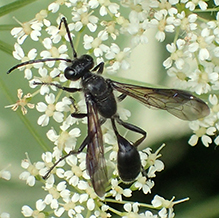 |
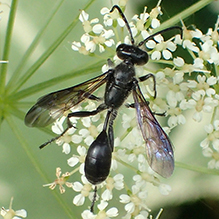 |
|
Isodontia mexicana Isodontia mexicana, Mexican grass-carrying wasp, male. Photos taken at Barnes Prairie, Racine Co., WI. on June 18, 2024. |
||
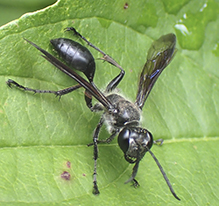 |
||
Mexican Grass-carrying Wasp Isodontia mexicana Isodontia mexicana, Mexican Grass-carrying Wasp on gray dogwood leaf. Barnes Prairie, Racine Co., WI July 15, 2021. |
|
|
Alfredo Colon |
||
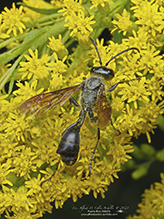 |
||
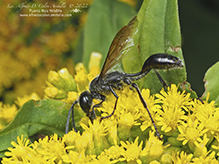 |
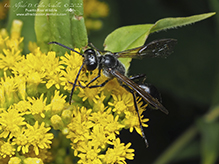 |
|
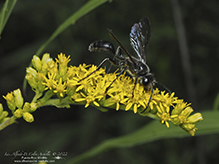 |
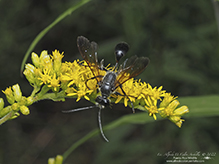 |
|
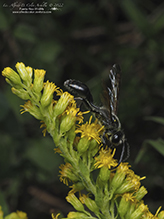 |
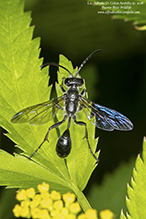 |
|
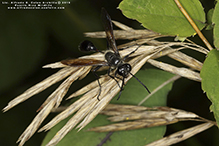 |
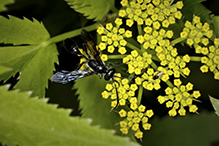 |
|
 |
 |
|
Whitey Com |
||
 |
|
|
Attempting to build a home in the support structure of a deck chair. |
|
|
MinnesotaSeasons.com Photos |
||
|
||
|
||

Slideshows |

Visitor Videos |
||
Share your video of this insect. |
||
This button not working for you? |
||
|
Other Videos |
||
Isodontia mexicana |
About
Published on Aug 28, 2009 |
Guepe solitaire Isodontia mexicana:Ponte |
About
Published on Mar 17, 2013 |

Visitor Sightings |
||
Report a sighting of this insect. |
||
This button not working for you? |
||
| Babette Kis 6/18/2024 |
Location: Barnes Prairie, Racine Co., WI Isodontia mexicana, Mexican grass-carrying wasp, male. Photos taken at Barnes Prairie, Racine Co., WI. on June 18, 2024. |
 |
| Judi Elliott 1/28/2024 |
Location: Flower Mound, Texas In two days we have had four of these wasps in our bathroom area. The first two flew toward us and seemed aggressive. The next two seemed almost as if they were dying. We have had our house closed due to freezing temps. No pets, no open windows. Cannot find the source. We don’t have other bugs - only an occasional spider. Any info? Will they soon be gone? |
|
| Alfredo Colon 8/25/2022 |
Location: Albany, NY |
 |
Lexie |
Location: Louisville, KY |
|
| Sally Benjamin 8/8/2023 |
Location: 2515 Smith Valley Rd, La Crosse, WI They are enjoying our red milkweed and elderberry flowers |
|
| Alfredo Colon 8/11/2022 |
Location: Albany, NY |
 |
| Alfredo Colon 8/2/2022 |
Location: Albany, NY |
 |
| Whitey Com 7/10/2022 |
Location: Excelsior, MN Attempting to build a home in the support structure of a deck chair. |
 |
| Babette Kis 7/15/2021 |
Location: Barnes Prairie, Racine Co., WI Isodontia mexicana, Mexican Grass-carrying Wasp on gray dogwood leaf. Barnes Prairie, Racine Co., WI July 15, 2021. |
 |
| Alfredo Colon 8/16 to 8/18/2019 |
Location: Slinger, Wisconsin |
 |
| Christine Gerjets 6/14/2019 |
Location: Glenwood MN; Pope County Building nest in window frame |
| Alfredo Colon 8/16/2018 |
Location: Woodbury, Minnesota |
 |
| Alfredo Colon 6/8/2018 |
Location: Woodbury, Minnesota |
 |
MinnesotaSeasons.com Sightings |
||

Created 9/23/2018 Last Updated: © MinnesotaSeasons.com. All rights reserved. |

